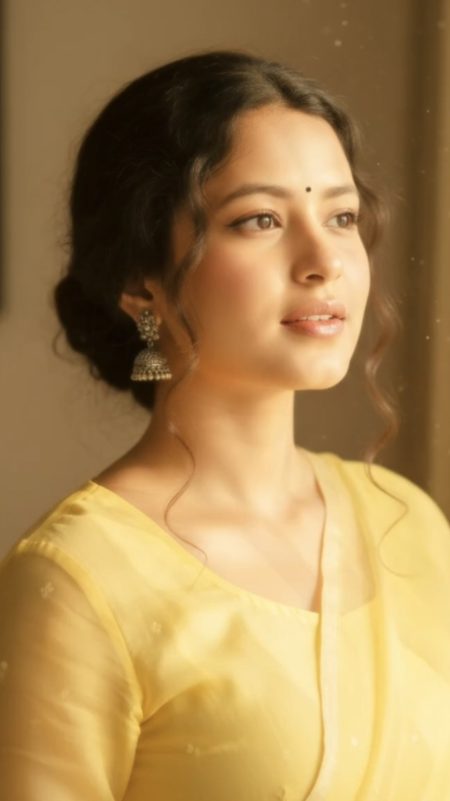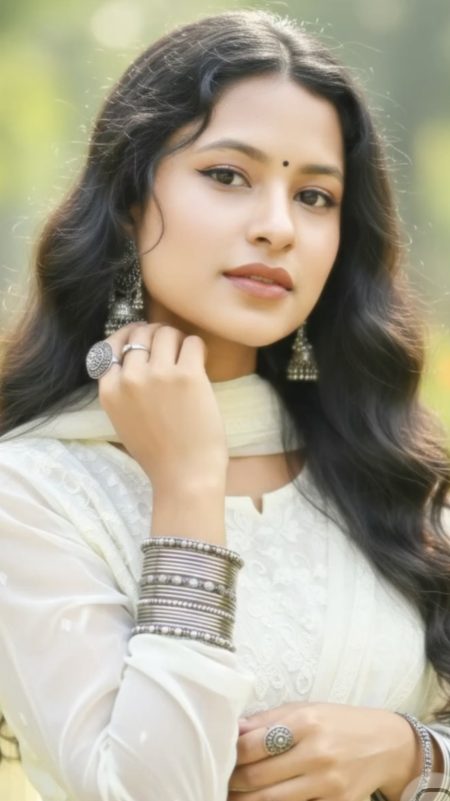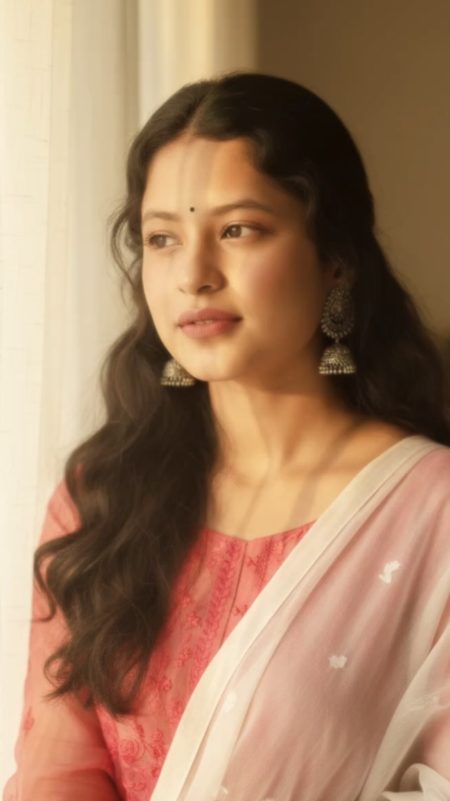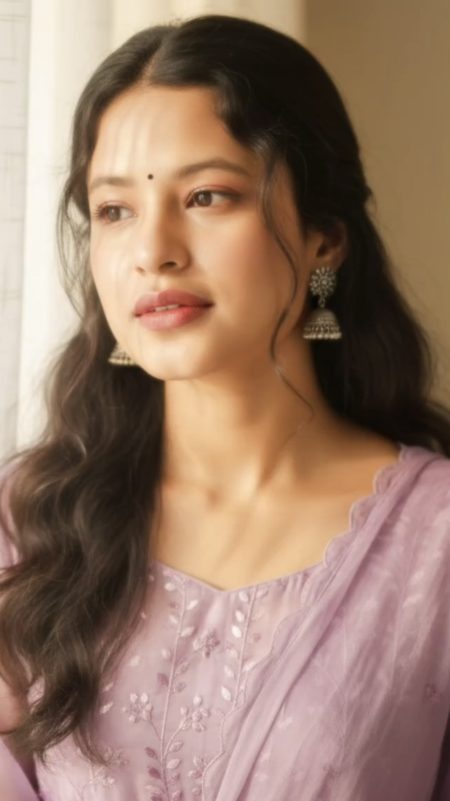Ultra-realistic fairytale princess portrait




There’s something deeply enchanting about portraits that blend tradition and softness, where the delicate hues of pastel fabrics meet the warmth of natural light. In an era where harsh digital filters are everywhere, this style of candid beauty in pastel traditions offers a refreshing pause—a return to elegance, sincerity, and quiet charm.
Imagine a series of portraits: one in pastel yellow, another in soft white, a third in gentle pink, and a final in dreamy lavender. Each image isn’t just about fashion—it’s an emotion captured in silk and sunlight. The key lies in combining traditional Indian attire, subtle makeup, serene poses, and ambient light to create visuals that feel both timeless and contemporary.
When crafting such portraits, the choice of color palette matters. Pastels—like buttery yellow, creamwhite, blush pink, and muted lavender—carry a softness that flatters skin tones while evoking calmness. These shades don’t compete for attention; they harmonize with the subject. Pairing them with lightly embroidered fabrics ensures texture without loud contrast. This approach lets details like silver oxidized jewelry, fine threadwork, and gentle folds become part of the conversation without overwhelming the frame.
Lighting is equally crucial. The ideal light is soft, diffused, and directional—sunlight filtered through curtains or window panes, or the gentle glow of a shaded outdoor space. This light sculpts the face with a luminous yet natural glow. Shadows should remain soft, not harsh. When you capture soft beams grazing the cheeks or highlighting a subtle curl, you create depth while maintaining a dreamy aesthetic.
Hair and styling should feel effortless. Soft waves or loose curls falling naturally, or a low bun with gentle face-framing tendrils, maintain fluidity. Hair should never fight the light—it should *flow* with it. For accessories, silver oxidized jhumkas, slender bangles, and delicate statement rings pair beautifully with pastel tones, adding tradition without distraction.
Makeup should whisper, not shout. A sheer base that enhances skin’s natural glow, light blush, soft neutral eyeshadow, a touch of mascara, and a rose-tinted lip balm go a long way. A small black bindi adds cultural grounding. The aim is to elevate, not transform—to capture the person, gently refined. Subtle retouching can smooth out minor blemishes, but resist over-editing. Let the small imperfections preserve authenticity.
Picturing four portraits side by side helps you see the continuity: the pastel yellow look glowing in warm sunlight, the white ensemble against a green garden blur, the pink version near a window frame, and the lavender style in diffused light. Though each outfit differs, the visual language is consistent: softness, minimalism, tradition, natural beauty. Together they form a cohesive aesthetic narrative.
Color transitions across those four portraits tell a story. Starting with warm yellow fading to ivory, then shifting to blush and ending in lavender—it’s almost like walking through a gentle dawn-to-evening light gradient. This progression adds emotional resonance. A viewer’s eye travels from one image to the next, sensing continuity in tone, expression, and mood.
When photographing, choose poses that feel relaxed. A sideways glance, a soft smile, looking out a window, or gently touching the chin—these simple actions often yield the most compelling frames. Never force posture; allow the subject to move gently and capture the spontaneous moments. Those natural gestures—the tilt of the head, a stray hair in motion—bring life to a still image.
Do pay attention to background and framing. Use shallow depth of field (wide aperture) so the subject remains sharply in focus while the backdrop melts into a painterly blur. Neutral or softly colored walls, sheer curtains, foliage, or sunlight patterns complement pastels without clashing. Avoid busy or high-contrast patterns that detract from the serene mood.
Post-production should maintain that light, airy feel. Slight adjustments to exposure, contrast, and color balance are fine; aim for slightly warmer tones, gentle highlights, and muted shadows. Don’t oversaturate—pastels live in their restraint. Use subtle vignettes to draw attention inward, and make sure skin tones remain harmonious and gentle throughout the series.
In terms of storytelling, you can present these portraits as chapters in an aesthetic diary—“Yellow whispers,” “Pure serenity,” “Blush dreams,” “Lavender reflections.” Each image can carry a short caption or mood-line that complements without overpowering. For instance: “When morning light kisses soft silk” or “In the hush of lilac twilight.” This narrative thread binds the collection into a cohesive visual story.
On a website, gallery pages or blog posts featuring such a series will draw attention—not just from aesthetics lovers, but from fashion, bridal, portrait, and art communities. Keywords like integrate naturally into descriptions and metadata. These terms directly reflect what viewers might search when seeking inspiration or photography ideas.
By weaving your visual direction with SEO-conscious language, you can publish these images with supportive text that helps people find them. Describe each look, mention the outfit color, setting (window-lit interior, garden blur, curtain light), the jewelry (silver oxidized, jhumkas), and the mood (dreamy, candid, serene). These descriptive lines strengthen search relevance without feeling forced.
In your blog or gallery page markup, always include alt text for the images—phrases like “pastel yellow saree portrait in natural sunlight,” “white kurta with silver jhumkas in garden blur,” or “lavender traditional attire with soft window light.” Alt text improves accessibility and gives search engines more context for your visuals.
Beyond photography, this aesthetic can inform editorial styling, mood board creation, social media campaigns, and even product catalogs. Brands catering to ethnic wear, handcrafted jewelry, bridal fashion, or heritage textiles could adopt this pastel-tradition narrative to present products in a fresh, emotionally engaging light.
Finally, authenticity is the heart of this aesthetic. The goal isn’t to build perfection, but to capture personality bathed in gentle color and light. When your model is comfortable, when hair and fabric move in real time, when the light plays on skin—you’ve hit the magic zone.
In crafting your own candid beauty in pastel traditions, remember: pastel shades add softness, natural light sculpts mood, traditional pieces bring grounding, and minimal retouching preserves honesty. Each element works together to create portraits that aren’t just visually pleasing—they feel like memories whispered through color and light.
Whether you're a photographer, stylist, blogger, or bride-to-be planning a shoot, this aesthetic offers a template and a visual philosophy. Use it as inspiration, adapt it to your own vision, but always let the softness and sincerity shine through. Light your subject gently, dress them in pastels, frame them with intention—and you’ll see how candid beauty meets tradition in perfect harmony.
Thank you for reading this exploration of pastel traditions in portraiture. Let this style guide and aesthetic narrative be a stepping stone for your next creative project. May your lenses catch many more moments of serene elegance.
